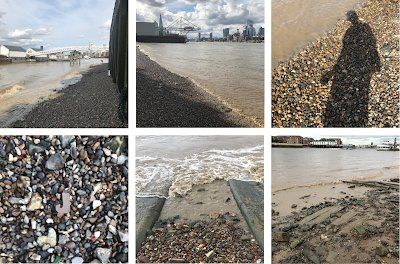I do love an 1930's pub. By which I mean one of those Tudor Revival or Neo Georgian houses built by the big breweries at that time in an effort to keep up with new innovations in construction, design and facilities, whilst holding onto old comforts, like log fires, polished wood and deep-buttoned leather chairs.
I often stop at an example of one of these on my Art Deco guided walks, explaining that not everyone was keen on the new fangled Moderne and geometric or streamlined styling, hence the many public houses were rebuilt in a way that would entice new and younger customers yet wouldn't scare off the existing clientele. I have often been heard saying that a customer back then could be quaffing either a pint of stout or a gin cocktail whilst smoking a pipe or a dragging on a cork-tipped Craven-A.
Well, at the side of Euston Station, this is illustrated in wood within the walls around the fireplaces of The Royal George public house, Grade II listed and for good reason.
There has been a pub here since 1877, named after the HMS Royal George, a Royal Navy flagship vessel that sank in 1873 with the loss of 1,200 crew. In the late 1930s, Truman Hanbury & Buxton, the then owners (hence the those lovely eagles on the building) rebuilt the pub with its front designed to echo the stern of the boat.The boat is depicted in its full glory inside the pub with sails a-billowing within a magnificent large marquetry panel, on the right hand side as you enter, above what would have been an open fireplace. It's hard to get a decent pic in there because the pub seems to constantly be showing sports on multiple TV screens and these are reflected in the wooden panel. However, we shouldn't really complain because in recent memory the marquetry panel was itself was covered by one of those TV screens, so we are lucky it wasn't removed, boarded or overpainted:
But that's not all. On the other side of the pub, in what would have originally been one of the other two bars, separated by walls or panels and accessible by its own street door, there is a non-functional angled fireplace in the far left corner with slim panels of marquetry either side.
Within these panels, and again, hard to photograph due to the poor lighting conditions in there, hence I am only showing eight of them here, the age of steam and science is contrasted with the age of cocktails:
As you can see, these graphics created from thin slivers of different woods, depict a range of subjects such as the brewing industry, bar games (skittles), science, engineering, transport and travel (luggage on a trolley).
I think these panels are absolutely marvellous. It amazes me when I take friends and fans of this sort of thing into The Royal George and other drinkers in there look at us quizzically as if we are the idiots!
Marquetry is a skilled and time-consuming craft that is dying out today. Find out more here. I have only found a few other examples within other London public buildings, albeit nothing comparable to the illustrative quality shown above. I will endeavour to hunt out some more (any excuse for a pub crawl!) – there surely must be more out there, simply hiding in plain sight – please let me know if you can add to the collection.







